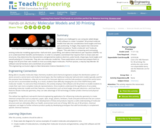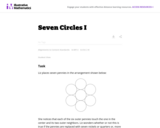
Learn about drawing shapes using only a compass and straight edge or ruler with out measuring any lengths or angles.
- Subject:
- Mathematics
- Material Type:
- Interactive
- Provider:
- Math Open Reference
- Date Added:
- 08/07/2023

Learn about drawing shapes using only a compass and straight edge or ruler with out measuring any lengths or angles.

What angles can you see in these photos of Olympic sports? Can you estimate them? This challenging activity is aimed at older primary pupils at Key Stage 2.

Download these free worksheets to sharpen your measurement skills. Sheets focus on temperature, conversion, area and perimeter, volume, and more.

This video demonstrates the three ways for naming an angle: by its vertex, by the three points of the angle, or by a letter or number written within the opening of the angle.

Angles are measured in degrees, and are classified as right, obtuse, acute, or straight.

Vertical angles lie diagonally opposite one another at an intersection and are always equal in measure. This makes them congruent.

Demonstrates how to use a protractor to measure angles. [4:05]
Khan Academy learning modules include a Community space where users can ask questions and seek help from community members. Educators should consult with their Technology administrators to determine the use of Khan Academy learning modules in their classroom. Please review materials from external sites before sharing with students.

Explains what a protractor is and how it is used to measure the size of angles. Also discusses the different types of angles. [8:23]
Khan Academy learning modules include a Community space where users can ask questions and seek help from community members. Educators should consult with their Technology administrators to determine the use of Khan Academy learning modules in their classroom. Please review materials from external sites before sharing with students.

Students are challenged to use computer-aided design (CAD) software to create “complete” 3D-printed molecule models that take into consideration bond angles and lone-pair positioning. To begin, they explore two interactive digital simulations: “build a molecule” and “molecule shapes.” This aids them in comparing and contrasting existing molecular modeling approaches—ball-and-stick, space-filling, and valence shell electron pair repulsion (VSEPR)—so as to understand their benefits and limitations. In order to complete a worksheet that requires them to draw Lewis dot structures, they determine the characteristics and geometries (valence electrons, polar bonds, shape type, bond angles and overall polarity) of 12 molecules. They also use molecular model kits. These explorations and exercises prepare them to design and 3D print their own models to most accurately depict molecules. Pre/Post quizzes, a step-by-step Blender 3D software tutorial handout and a worksheet are provided.

(Nota: Esta es una traducción de un recurso educativo abierto creado por el Departamento de Educación del Estado de Nueva York (NYSED) como parte del proyecto "EngageNY" en 2013. Aunque el recurso real fue traducido por personas, la siguiente descripción se tradujo del inglés original usando Google Translate para ayudar a los usuarios potenciales a decidir si se adapta a sus necesidades y puede contener errores gramaticales o lingüísticos. La descripción original en inglés también se proporciona a continuación.)
Este módulo de 20 días introduce puntos, líneas, segmentos de línea, rayos y ángulos, así como las relaciones entre ellos. Los estudiantes construyen, reconocen y definen estos objetos geométricos antes de usar su nuevo conocimiento y comprensión para clasificar las cifras y resolver problemas. Con la medida de ángulo que juega un papel clave en su trabajo a lo largo del módulo, los estudiantes aprenden cómo crear y medir ángulos, así como crear y resolver ecuaciones para encontrar medidas de ángulo desconocidas. En estos problemas, donde el ángulo desconocido está representado por una letra, los estudiantes exploran ambos midiendo el ángulo desconocido con un protractor y razonamiento a través de la resolución de una ecuación. A través de actividades de descomposición y composición, así como una exploración de la simetría, los estudiantes reconocen atributos específicos presentes en figuras bidimensionales. Desarrollan su comprensión de estos atributos a medida que clasifican las figuras bidimensionales basadas en ellas.
Encuentre el resto de los recursos matemáticos de Engageny en https://archive.org/details/engageny-mathematics.
English Description:
This 20-day module introduces points, lines, line segments, rays, and angles, as well as the relationships between them. Students construct, recognize, and define these geometric objects before using their new knowledge and understanding to classify figures and solve problems. With angle measure playing a key role in their work throughout the module, students learn how to create and measure angles, as well as create and solve equations to find unknown angle measures. In these problems, where the unknown angle is represented by a letter, students explore both measuring the unknown angle with a protractor and reasoning through the solving of an equation. Through decomposition and composition activities as well as an exploration of symmetry, students recognize specific attributes present in two-dimensional figures. They further develop their understanding of these attributes as they classify two-dimensional figures based on them.
Find the rest of the EngageNY Mathematics resources at https://archive.org/details/engageny-mathematics.

(Nota: Esta es una traducción de un recurso educativo abierto creado por el Departamento de Educación del Estado de Nueva York (NYSED) como parte del proyecto "EngageNY" en 2013. Aunque el recurso real fue traducido por personas, la siguiente descripción se tradujo del inglés original usando Google Translate para ayudar a los usuarios potenciales a decidir si se adapta a sus necesidades y puede contener errores gramaticales o lingüísticos. La descripción original en inglés también se proporciona a continuación.)
Así como se utilizan movimientos rígidos para definir la congruencia en el Módulo 1, se agregan dilataciones para definir la similitud en el Módulo 2. Para poder discutir la similitud, los estudiantes primero deben comprender claramente cómo se comportan las dilataciones. Esto se hace en dos partes, al estudiar cómo las dilataciones producen dibujos de escala y razonando por qué las propiedades de las dilataciones deben ser ciertas. Una vez que las dilataciones se establecen claramente, se definen transformaciones de similitud y se examinan las relaciones de longitud y ángulo, lo que produce criterios de similitud triangular. Sigue una mirada profunda a la similitud dentro de los triángulos rectos, y finalmente el módulo termina con un estudio de trigonometría del triángulo recto.
Encuentre el resto de los recursos matemáticos de Engageny en https://archive.org/details/engageny-mathematics.
English Description:
Just as rigid motions are used to define congruence in Module 1, so dilations are added to define similarity in Module 2. To be able to discuss similarity, students must first have a clear understanding of how dilations behave. This is done in two parts, by studying how dilations yield scale drawings and reasoning why the properties of dilations must be true. Once dilations are clearly established, similarity transformations are defined and length and angle relationships are examined, yielding triangle similarity criteria. An in-depth look at similarity within right triangles follows, and finally the module ends with a study of right triangle trigonometry.
Find the rest of the EngageNY Mathematics resources at https://archive.org/details/engageny-mathematics.

In this lesson, students will learn angle relationships and use these relationships to solve problems.

Demonstrates how to solve problems that ask you to identify types of angles. [2:15]
Khan Academy learning modules include a Community space where users can ask questions and seek help from community members. Educators should consult with their Technology administrators to determine the use of Khan Academy learning modules in their classroom. Please review materials from external sites before sharing with students.

In this activity, students recognize the relationship of angles to circles. They study the Inscribed Angle Theorem and its corollaries.

This task is intended to help model a concrete situation with geometry. Placing the seven pennies in a circular pattern is a concrete and fun experiment which leads to a genuine mathematical question: does the physical model with pennies give insight into what happens with seven circles in the plane?

This video discusses coterminal angles which are angles that share the same terminal arms. [17:06]

Excellent site reviewing the realms of Trigonometry. Topics Include the trig functions, graphs, right triangles and much more.

Uncover the hidden picture by correctly matching geometry terms to their corresponding diagrams. This fun interactive online game will have your students asking to practice their math!

Find a quick, concise explanation of angles and types of angles. Several examples are given to help you understand how angles are formed and the different types of angles.

If you're looking for the measurements of the interior angles of a triangle you can use this tutorial to see how to use a given ratio of the interior angles and the Triangle Sum Theorem to find those missing measurements. [5:39]